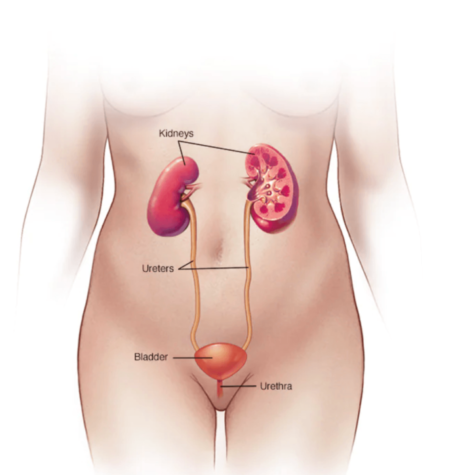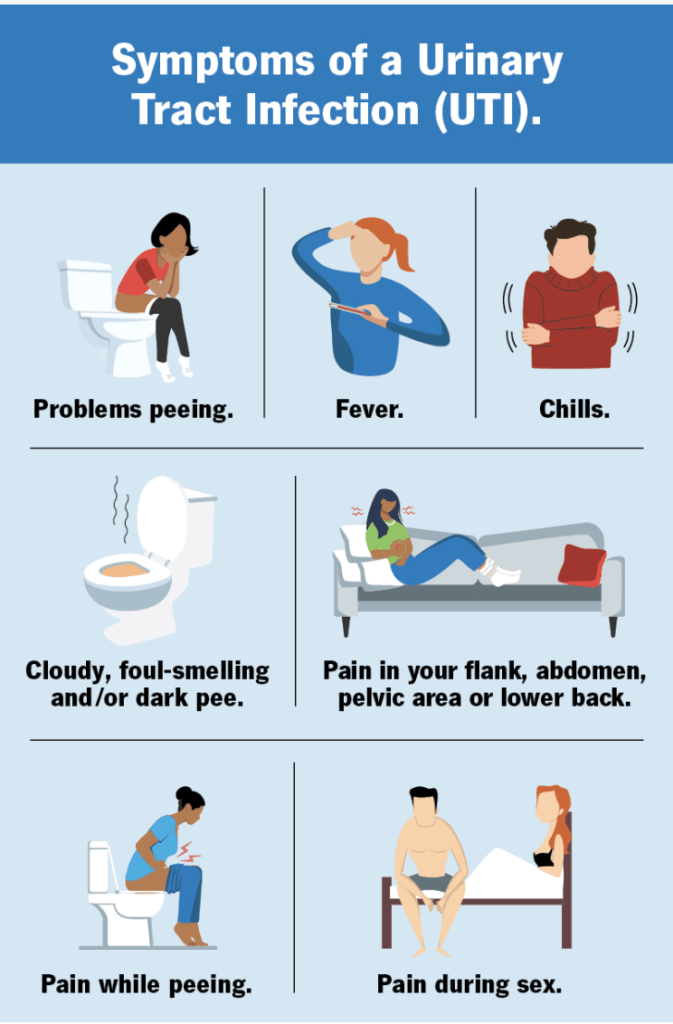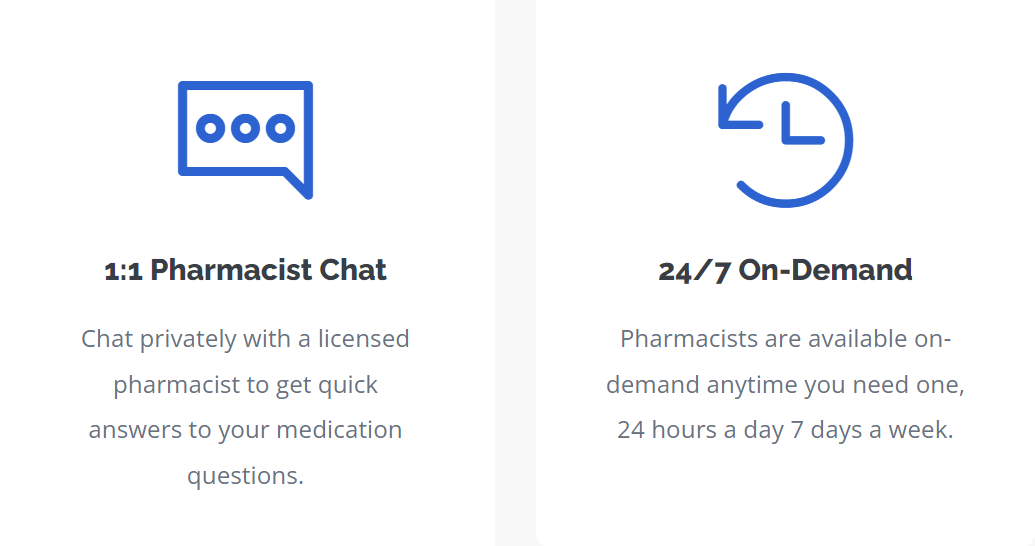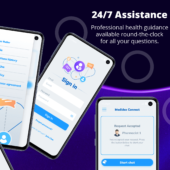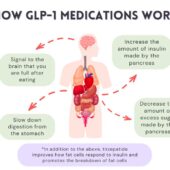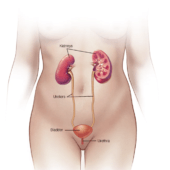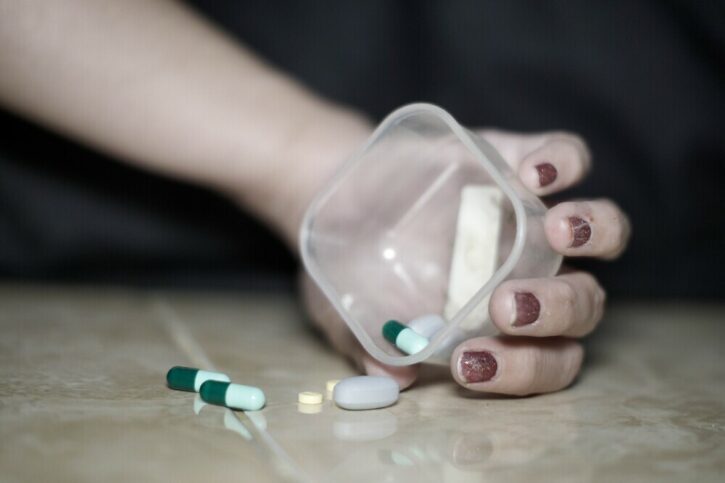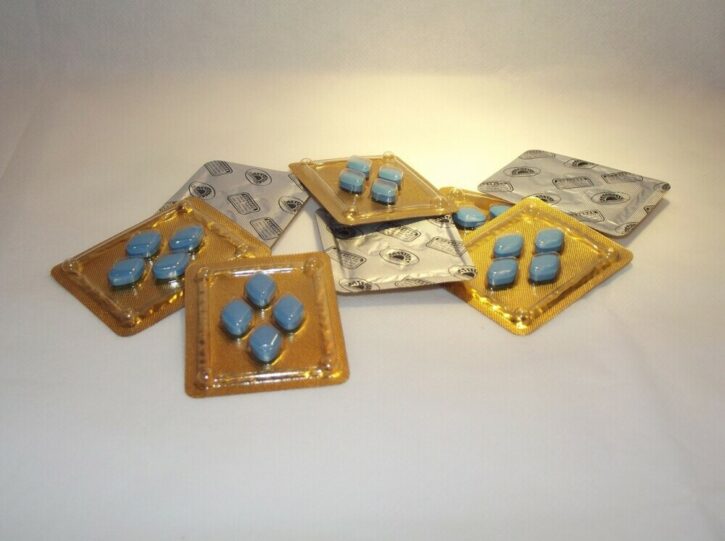Are you wondering what is a UTI (short for Urinary Tract Infection)? Read below for information on UTI’s and their symptoms, as well as how to diagnose and how to treat a UTI (including home remedies for a UTI, over-the-counter UTI medications, and common antibiotics for a UTI).
Once you’re done reading, if you have more questions about UTI’s or home remedies and medications used to treat a UTI, ask a pharmacist online 24/7 using Medidex Connect.
What is a UTI (Urinary Tract Infection)?
Urinary tract infections include cystitis and pyelonephritis. Cystitis is an infection of the bladder or lower urinary tract, whereas pyelonephritis is an infection of the kidney or upper urinary tract. Some of the risk factors for UTIs include female anatomy, sexual activity, menopause, a suppressed immune system, blockages in the urinary tract, or catheter use.
Symptoms of Cystitis (Lower UTI or Bladder Infection)
- Dysuria, which is painful urination
- Increase in frequency and urgency of urination
- Pelvic pressure
- Blood in the urine
Symptoms of Pyelonephritis (Upper UTI or Kidney Infection)
- Symptoms of cystitis plus
- Back or side pain
- Fever or chills
- Nausea or vomiting
- Malaise
Diagnosis and Test for UTI
A healthcare provider will conduct a urinalysis to diagnose a urinary tract infection. During this procedure, the patient will be required to provide a urine sample for laboratory analysis to detect the presence of nitrates, leukocyte esterase, and white blood cells. An additional diagnostic method involves a urine culture, where the sample is tested to cultivate and identify any bacteria. This information will assist the healthcare provider in determining the most effective course of treatment. If the infection does not respond to the prescribed treatment, an ultrasound may be conducted to facilitate a thorough examination of your internal organs. An alternative course of action involves a cystoscopy, wherein a cystoscope is utilized to inspect the interior of your bladder through the urethra.
How to Treat UTI’s
Home Remedies for a UTI
For a urinary tract infection (UTI), home treatment may help alleviate symptoms, but they should not replace professional medical treatment, especially if the infection is moderate to severe. Here are some home remedies for a UTI that may help manage mild symptoms or complement medical treatment:

- Hydration
- Drink plenty of water: Drinking water helps flush out bacteria from the urinary system.
- Cranberry juice: Unsweetened cranberry juice is believed to help prevent bacteria from adhering to the bladder walls. Though evidence is mixed, cranberry juice remains one of the most common home remedies for a UTI. If you try it, opt for 100% pure cranberry juice with no added sugars.
- Probiotics
- Probiotics, especially those containing Lactobacillus are often used in home remedies for a UTI. This is because probiotics may help maintain healthy gut and urinary flora, which can support the body’s defense against infections. Probiotic-rich foods include yogurt, kefir, sauerkraut, and kimchi.
- Probiotics, especially those containing Lactobacillus are often used in home remedies for a UTI. This is because probiotics may help maintain healthy gut and urinary flora, which can support the body’s defense against infections. Probiotic-rich foods include yogurt, kefir, sauerkraut, and kimchi.
- D-Mannose
- This is a type of sugar found in fruits like cranberries and apples. It may help prevent bacteria from sticking to the bladder walls and is available in supplement form.
- This is a type of sugar found in fruits like cranberries and apples. It may help prevent bacteria from sticking to the bladder walls and is available in supplement form.
- Vitamin C
- Vitamin C can acidify urine, making it less friendly for bacterial growth. Consuming fruits high in vitamin C like oranges, strawberries, or taking a supplement may support healing.
- Vitamin C can acidify urine, making it less friendly for bacterial growth. Consuming fruits high in vitamin C like oranges, strawberries, or taking a supplement may support healing.
- Herbal Remedies
- Uva ursi (bearberry leaf): Traditionally used for UTIs, uva ursi may help reduce infection, though it should only be used short-term and under guidance, as it can have side effects.
- Garlic: Known for its antimicrobial properties, raw garlic or garlic supplements may help combat infection.
- Heating Pads
- A heating pad on your lower abdomen may help relieve the discomfort or pressure associated with UTIs.
- A heating pad on your lower abdomen may help relieve the discomfort or pressure associated with UTIs.
- Hygiene Practices
- Wipe from front to back to prevent bacteria from spreading.
- Urinate after sexual intercourse to help flush bacteria from the urinary tract.
- Baking Soda (Sodium Bicarbonate)
- Some people use baking soda dissolved in water (½ teaspoon in a glass of water) to help neutralize the acidity in urine, providing relief from burning sensations during urination. However, this should be used cautiously and under a doctor’s advice, as it can disrupt the body’s natural acid-base balance.
- Some people use baking soda dissolved in water (½ teaspoon in a glass of water) to help neutralize the acidity in urine, providing relief from burning sensations during urination. However, this should be used cautiously and under a doctor’s advice, as it can disrupt the body’s natural acid-base balance.
- Avoid Irritants
- Stay away from caffeine, alcohol, spicy foods, and artificial sweeteners, as these can irritate the bladder and worsen symptoms.
While these home remedies for a UTI can provide some relief, it’s important to consult a healthcare provider, especially if symptoms persist or worsen. A UTI can spread to the kidneys if left untreated, which can be serious. Continue reading for a list of over-the-counter UTI medications and commonly prescribed antibiotics for a UTI.
Over the Counter UTI medications
Over-the-counter (OTC) medications can help alleviate the symptoms of a urinary tract infection (UTI), but they don’t cure the infection itself. Here are some common OTC options for managing UTI symptoms:
- Phenazopyridine (Pyridium, AZO)
- Purpose of phenazopyridine (Pyridium, AZO): Azo is a medication that frequently relieves urinary tract symptoms such as pain, burning, discomfort and urinating.
- How phenazopyridine (Pyridium, AZO) works: Azo is a dye which numbs and soothea the lining of the urinary tract. This medication is taken three times a day with food for two days. Azo can discolor urine to red or orange.
- Important note on phenazopyridine (Pyridium, AZO): Azo is for symptom relief only and does not treat the infection. It can turn urine a bright orange or red color, which is normal but may stain clothes or contact lenses.
- Cystex Urinary Pain Relief Tablets
- Purpose of Cystex Tablets: Combines a mild pain reliever with an antibacterial agent (methenamine) to help control infection symptoms and reduce pain.
- How Cystex Tablets work: The antibacterial component helps suppress the growth of bacteria in the urine, while the pain reliever targets discomfort.
- Important note on Cystex Tablets: It’s not a substitute for antibiotics but may help with mild UTIs or as a temporary measure.
Important Note: OTC medications and home remedies for a UTI can provide symptom relief but do not cure the infection. Antibiotics are required to fully treat a UTI, so it’s essential to consult a healthcare provider if you suspect you have a UTI. If left untreated, a UTI can progress into a more severe kidney infection.
Common Antibiotics for a UTI
Home remedies for a UTI and over-the-counter UTI medications are, unfortunately, often not strong and fast acting enough to provide the treatment and relief people are seeking. Antibiotics for a UTI are often required to treat an active urinary tract infection.
- Trimethoprim and Sulfamethoxazole (Bactrim, Bactrim DS)
- Bactrim, also known as sulfamethoxazole and trimethoprim, is an antibiotic medication in the sulfa drug class. It is commonly used to treat various bacterial infections, including urinary tract infections, ear infections, traveler’s diarrhea, and bronchitis. Bactrim is typically taken orally, with a recommended dosage of twice a day and a full glass of water. It’s essential to complete the entire course of treatment as prescribed by your healthcare provider, even if your symptoms improve before the medication is finished. If you experience any adverse reactions or have concerns about taking Bactrim, it’s essential to consult with your healthcare professional for guidance.
- Bactrim, also known as sulfamethoxazole and trimethoprim, is an antibiotic medication in the sulfa drug class. It is commonly used to treat various bacterial infections, including urinary tract infections, ear infections, traveler’s diarrhea, and bronchitis. Bactrim is typically taken orally, with a recommended dosage of twice a day and a full glass of water. It’s essential to complete the entire course of treatment as prescribed by your healthcare provider, even if your symptoms improve before the medication is finished. If you experience any adverse reactions or have concerns about taking Bactrim, it’s essential to consult with your healthcare professional for guidance.
- Nitrofurantoin (Macrobid)
- Nitrofurantoin is an antibiotic used to treat urinary tract infections caused by bacteria. It is available in capsule and suspension (liquid) forms and can be taken by mouth. Nitrofurantoin is typically taken with food twice or four times daily for at least seven days. It’s crucial to take nitrofurantoin at the same time every day. Shake the liquid thoroughly before each use to ensure the medication is evenly mixed. Use a dose-measuring spoon or cup to measure the correct amount of liquid for each dose; do not use a household spoon.It’s crucial to complete the entire course of nitrofurantoin as prescribed, even if symptoms improve. Stopping the medication or missing doses can complicate treatment and lead to bacterial resistance.
- Nitrofurantoin is an antibiotic used to treat urinary tract infections caused by bacteria. It is available in capsule and suspension (liquid) forms and can be taken by mouth. Nitrofurantoin is typically taken with food twice or four times daily for at least seven days. It’s crucial to take nitrofurantoin at the same time every day. Shake the liquid thoroughly before each use to ensure the medication is evenly mixed. Use a dose-measuring spoon or cup to measure the correct amount of liquid for each dose; do not use a household spoon.It’s crucial to complete the entire course of nitrofurantoin as prescribed, even if symptoms improve. Stopping the medication or missing doses can complicate treatment and lead to bacterial resistance.
- Fosfomycin (Monurol)
- Fosfomycin is an antibiotic used to treat urinary tract infections. It is available as granules that must be mixed with water and taken orally. Do not take the dry granules without first diluting them in water. To prepare a dose, empty the contents of a single-dose packet into a glass and add 3 to 4 ounces (90 to 120 milliliters) of cold water. Stir until dissolved. Do not use hot water. Take the prepared dose by mouth as soon as possible.
- Fosfomycin is an antibiotic used to treat urinary tract infections. It is available as granules that must be mixed with water and taken orally. Do not take the dry granules without first diluting them in water. To prepare a dose, empty the contents of a single-dose packet into a glass and add 3 to 4 ounces (90 to 120 milliliters) of cold water. Stir until dissolved. Do not use hot water. Take the prepared dose by mouth as soon as possible.
- Cephalexin (Keflex)
- Cephalexin belongs to a class of medications known as cephalosporin antibiotics. It works by eliminating bacteria. Cephalexin is available in capsule, tablet, and suspension (liquid) forms. Typically, it is taken every 6 or 12 hours with or without food for a period of 7 to 14 days, depending on the condition being treated. It’s important to continue taking cephalexin until you finish the prescribed course, even if you start feeling better. If you stop taking cephalexin too early or miss doses, your infection may not be fully treated, and the bacteria could develop resistance to antibiotics.
- Cephalexin belongs to a class of medications known as cephalosporin antibiotics. It works by eliminating bacteria. Cephalexin is available in capsule, tablet, and suspension (liquid) forms. Typically, it is taken every 6 or 12 hours with or without food for a period of 7 to 14 days, depending on the condition being treated. It’s important to continue taking cephalexin until you finish the prescribed course, even if you start feeling better. If you stop taking cephalexin too early or miss doses, your infection may not be fully treated, and the bacteria could develop resistance to antibiotics.
- Ciprofloxacin (Cipro)
- Ciprofloxacin belongs to the class of drugs known as quinolone antibiotics. It works by killing bacteria or preventing their growth. Ciprofloxacin comes in tablets, liquid suspension, and extended-release tablets that can be taken orally with or without food. The tablets and suspension are usually taken twice a day, while the extended-release tablets are usually taken once a day. It’s important to swallow the tablets whole and not crush or chew them. It’s also recommended not to take ciprofloxacin with dairy products or calcium-fortified juices alone. Ciprofloxacin may cause problems with bones, joints, and tissues around joints in children. Therefore, it should not usually be given to children under 18 unless they have certain serious infections.
- Ciprofloxacin belongs to the class of drugs known as quinolone antibiotics. It works by killing bacteria or preventing their growth. Ciprofloxacin comes in tablets, liquid suspension, and extended-release tablets that can be taken orally with or without food. The tablets and suspension are usually taken twice a day, while the extended-release tablets are usually taken once a day. It’s important to swallow the tablets whole and not crush or chew them. It’s also recommended not to take ciprofloxacin with dairy products or calcium-fortified juices alone. Ciprofloxacin may cause problems with bones, joints, and tissues around joints in children. Therefore, it should not usually be given to children under 18 unless they have certain serious infections.
- Levofloxacin (Levaquin)
- Levofloxacin is a type of quinolone antibiotic. It is available in tablet and liquid form for oral administration. The typical dosage is once per day, and the tablet can be taken with or without food. However, the liquid form should be taken either 1 hour before or 2 hours after eating. It’s crucial to take levofloxacin at the same time each day. Also, ensure that you drink plenty of water or other fluids while taking this medication.
- Levofloxacin is a type of quinolone antibiotic. It is available in tablet and liquid form for oral administration. The typical dosage is once per day, and the tablet can be taken with or without food. However, the liquid form should be taken either 1 hour before or 2 hours after eating. It’s crucial to take levofloxacin at the same time each day. Also, ensure that you drink plenty of water or other fluids while taking this medication.
- Ceftriaxone (Rocephin)
- Ceftriaxone is a type of cephalosporin antibiotic that works by killing bacteria or stopping their growth. It is administered through injection, either as a powder mixed with liquid or as a premixed product. The injection is given intravenously over a period of 30 or 60 minutes, or it can be given into a muscle. The dosage varies based on the specific infection being treated.
Ways to Prevent UTI
- Drink 6-8 glasses of water daily to help bacteria flush out from the urinary tract.
- Wipe from front to back after urinating to prevent the spread of bacteria.
- Empty your bladder after having sex.
- Avoid irritating feminine products.
Final Thoughts on How to Treat a UTI and Home Remedies for a UTI
Treating a urinary tract infection (UTI) effectively requires a combination of symptom management and addressing the underlying infection. The gold standard for UTI treatment is prescription antibiotics, which target and eliminate the bacteria causing the infection. While home remedies for a UTI and over-the-counter (OTC) medications for a UTI can help alleviate discomfort, they should never replace professional medical care, especially if symptoms worsen or persist.
When to See a Doctor
- Persistent symptoms: If symptoms last more than a day or two without improvement, or if they worsen.
- Severe pain or blood in urine: These could indicate a more severe infection.
- Fever or back pain: These may be signs of a kidney infection, which requires immediate medical attention.
- Frequent UTIs: If you experience recurring UTIs, your doctor may investigate underlying causes and recommend preventive measures.
Once diagnosed, a doctor will likely prescribe a course of antibiotics, which usually resolves symptoms within a few days. Completing the full course is crucial to ensure the infection is fully eradicated.
If you have additional questions about UTI’s, how to treat a UTI, and common UTI medications connect with a licensed pharmacist on-demand using Medidex Connect.
Disclaimer: This website does not provide medical advice. No content on this site is intended to be a substitute for professional medical advice, diagnosis, or treatment. All content on this site is for educational and informational purposes only, does not constitute medical advice, and does not establish any kind of patient-provider or client-professional relationship by your use of this website. Although we strive to strictly provide accurate and up to date general information, content available on this site is not a substitute for professional medical advice, and you should not rely solely on the information provided here. Always seek the advice of your physician or other qualified healthcare provider with any questions you may have regarding medical conditions, treatments, or medications.


